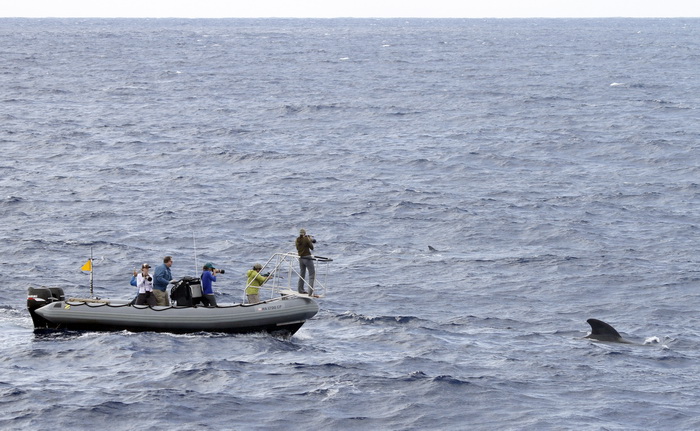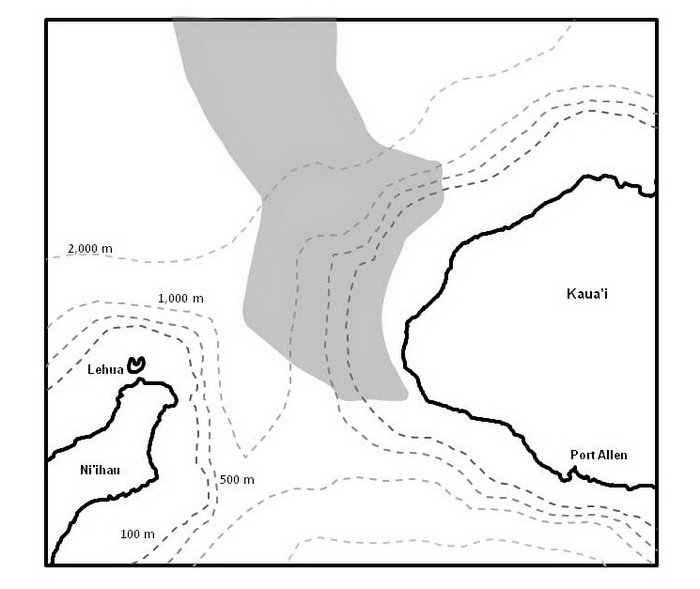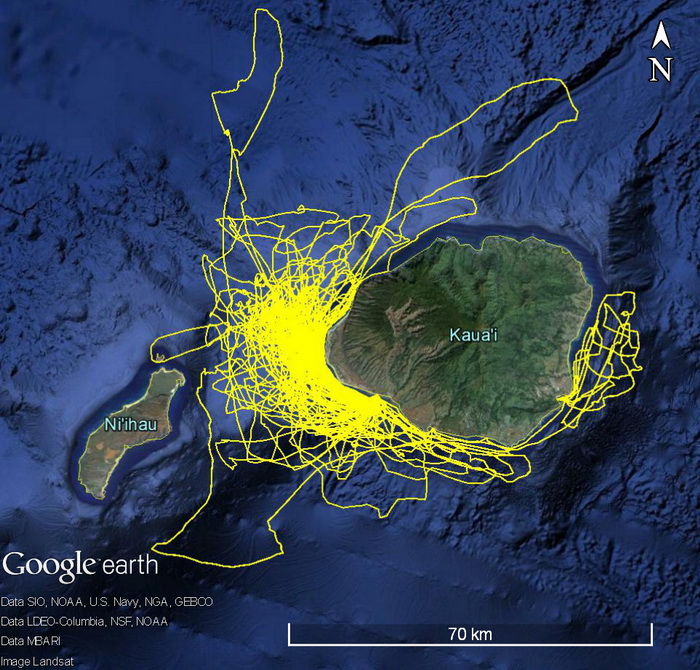Cascadia Research will be undertaking a 10-day field project off the island of Kaua‘i starting September 3rd, 2015. This will be our 13th field project working off Kaua‘i and Ni‘ihau, and our second one this year. This project is funded by the U.S. Navy through the Living Marine Resources program.
The primary purpose of the project is to obtain information on movements and habitat use of a number of species of toothed whales through the deployment of satellite tags. As we do during all of our field projects, we will also be obtaining photos from most species of odontocetes we encounter, to contribute to ongoing studies of residency patterns and social organization and to estimate population sizes, and collecting biopsy samples for toxicology and genetic studies. Last year we had two similar field projects, one in February and one in October, as well as a project in February this year, and like those projects we expect to have higher encounter rates than normal since we’ll be working in collaboration with the Marine Mammal Monitoring on Navy Ranges (M3R) program, using the Navy’s hydrophone range off Kaua‘i (see map below) to localize animals. When on the water we will be in constant contact with Navy researchers from the M3R program to help direct us to groups that they are detecting acoustically. This will allow us to confirm the species (to aid in using the acoustic range for research purposes on different species), and should make it much easier for us to find groups of whales and dolphins for tagging, photo-ID and biopsy sampling.
Species that we are hoping to satellite tag include rough-toothed dolphins, bottlenose dolphins, false killer whales, short-finned pilot whales, melon-headed whales, pygmy killer whales, sperm whales, Cuvier’s beaked whales, and Blainville’s beaked whales.
The research team includes Daniel Webster, Brenda Rone, Deron Verbeck, Kim Wood, Robin Baird, and a number of volunteers.
End of project update

September 12th was supposed to be our last day on the water, but thunderstorms and rainshowers covered the south side of the island for much of the day and we were unable to get out on the water. Overall though it was a very productive field effort, with depth-transmitting satellite tags deployed on four different species, and over 16,000 photos taken (most for individual photo-identification, but also a lot of seabirds and a few photos of the striking cliffs of Na Pali, the north side of Kaua‘i). Our next Hawai‘i field project will be off the Kona coast of Hawai‘i Island, and we hope to be off Kaua‘i in 2016.

Our research vessel off the cliffs of Na Pali, September 11, 2015. Photo by Robin W. Baird.
September 10th update

Today we encountered our fifth species of odontocete for the trip, a group of about 40 short-finned pilot whales. Winds were coming from the west, so we surveyed an area we rarely get to, off the east side of Ni‘ihau, and found the group off the south end of Ni‘ihau. Photo by Robin W. Baird.

We were able to deploy two depth-transmitting satellite tags, both on adult male pilot whales – adult males can be easily distinguished based on the large size of the dorsal fin. We also obtained identification photos of about 30 individuals, and will be comparing them to our photo-ID catalog to see whether they are part of the resident population, or a pelagic group moving through the area. Photo by Brenda K. Rone.

A pilot whale spyhopping, September 10, 2015. Photo by Kimberly A. Wood. For more information on pilot whales in Hawai‘i see our pilot whale page
September 7th update

Today we had one of our best encounters with rough-toothed dolphins, a group of over 80 individuals with many of them bowriding at one time. This photo shows two rough-toothed dolphins, showing the characteristic sloped head, large flippers, and protruding eyes. Photo by Robin W. Baird.
A short video from the encounter off Kauai, September 7, 2015. Video by Kim Wood.

Rough-toothed dolphins bowriding on our research vessel, September 7, 2015. Photo by Robin W. Baird.
September 6th update

Today we encountered our highest priority species, false killer whales. This photo shows a group of wedge-tailed shearwaters around a false killer whale off Napali – the shearwaters were probably following the whale hoping to pick up scraps from a recent kill. Photo by Brenda K. Rone.

There are two different resident populations of false killer whales that overlap around Kaua‘i and Ni‘ihau, the endangered main Hawaiian Islands population (that extends from the “big island” to Ni‘ihau), and the northwestern Hawaiian Islands population (that extends from western O‘ahu at least to Gardner Pinnacles in the northwestern Hawaiian Islands). With today’s encounter we were able to obtain identification photos of about 15 individuals, as well as one biopsy sample (for genetics). From a quick look at several distinctive individuals, we didn’t recognize any, so suspect this may have been the lesser-known northwestern Hawaiian Islands population. Photo by Brenda K. Rone.

A false killer whale from today, photo by Brenda K. Rone.

One way of telling adult male from adult female false killer whales is how much the upper jaw (the “nose”) overhangs the lower jaw – this individual is an adult male, with a much larger nose. Photo by Brenda K. Rone.
September 5th update

Our third day on the water today and we encountered our third species of odontocete for the trip, a group of about 24 bottlenose dolphins. Many of the individuals were very distinctive and we recognized some from previous trips – part of the resident population of bottlenose dolphins around Kaua‘i and Ni‘ihau. Photo by Julie E. Steelman.

We also encountered a group of rough-toothed dolphins, and were able to deploy our first satellite tag of the trip, a depth-recording tag. This is the 16th rough-toothed dolphin that we’ve tagged off the island over the last four years, and we are looking forward to tracking it’s movements over the next few weeks. Photo by Kim A. Wood.

A rough-toothed dolphin with it’s mouth open, September 4, 2015. Photo by Deron S. Verbeck
September 3rd update

A rough-toothed dolphin leaping off Kaua‘i, September 3, 2015. Photo by Kim A. Wood. With a hurricane passing far to the north, the typical wind patterns off Kaua‘i are disrupted, but in a good way, and today we were able to work further north than we are usually able to survey. We found four groups of rough-toothed dolphins today, including the largest group we’ve ever documented in the islands, an estimated 140 individuals.

A piebald rough-toothed dolphin off Kaua‘i, September 3, 2015. Photo by Deron S. Verbeck. There is a resident population of rough-toothed dolphins off the island, and we were able to get photos of perhaps 50 or more individuals to compare to our photo-identification catalog.

Our research vessel with short-finned pilot whales off Kaua‘i in February 2014. Photo by Jessica Aschettino.

Our study area for the project. The Navy’s hydrophone range it shaded – approximately 175 hydrophones are spread across the shaded area connected to the M3R system.

Our survey effort off Kaua‘i and Ni‘ihau over the last three years – this map shows tracklines from projects in 2012, 2013, 2014, and February 2015.
Photos should not be used without permission. Contact Robin Baird (rwbaird (at) cascadiaresearch.org) for permission.
Sign up to our Facebook page if you want to receive notices of when information is posted and updates on other Cascadia projects.